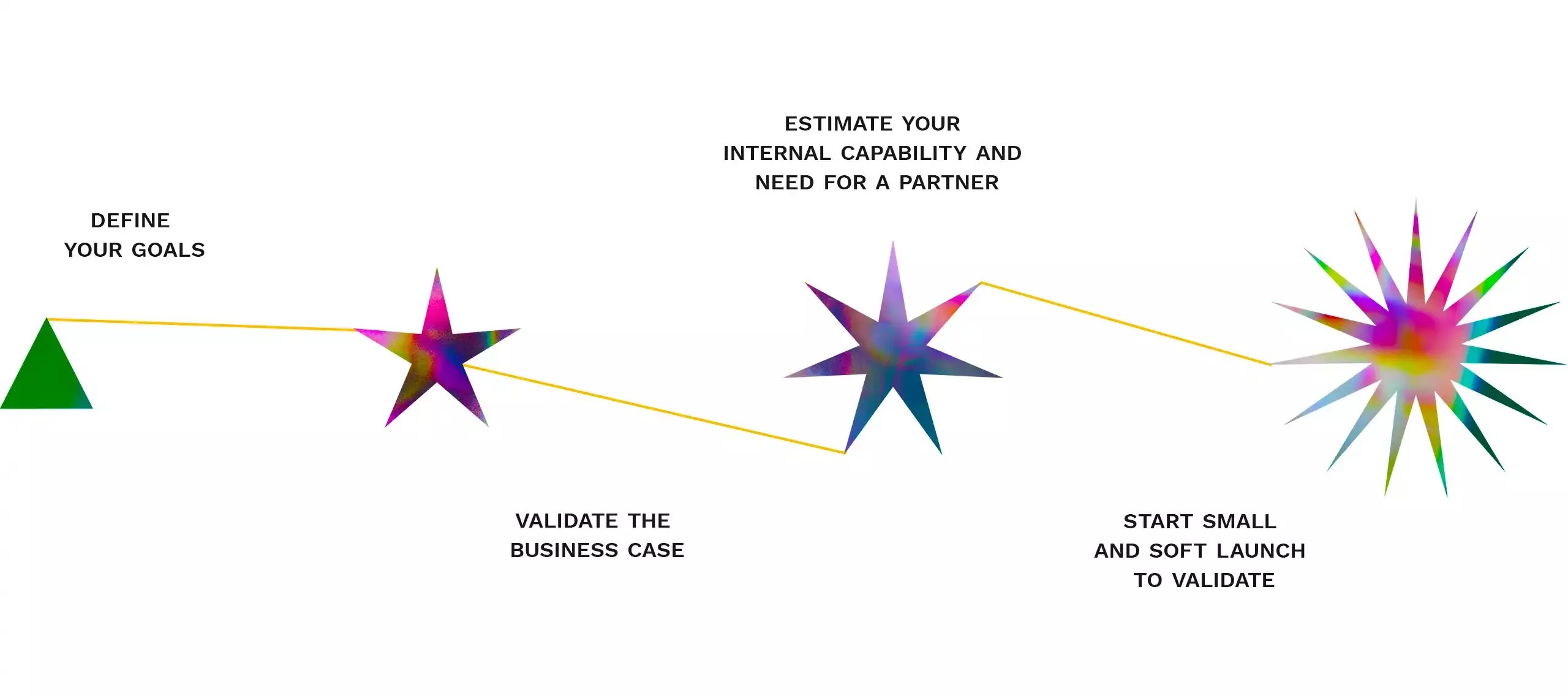Future-proof your ecommerce
Learn more about how we can help you with composable commerce
Explore composable commerceIn our blog we’ve explored what composable commerce is and when it is relevant to your company. If you’ve become convinced that the approach is a potential fit for you, here are four steps that help you succeed in your move.
1. DEFINE YOUR GOALS
Is your current ecommerce holding you back from growing and scaling? Or perhaps you keep running into other limitations in your digital sales, such as less-than-ideal customer experience or demotivated developers.
A successful move towards composable commerce starts with identifying the goals you're looking to reach. Identify where you want your ecommerce to be in a year or five years from now. Defining your goals helps you keep your focus and measure the impact of the move.
The following are some of the motivations moving companies towards composable commerce:
Better customer experience
The demands on your storefront might be more than what a monolithic solution can handle. The composable approach allows for flexible tweaking and customisation based on your customers' needs and your vision of how the store should look and feel. As the presentation layers are separated from the business logic, you can release changes in the storefront without affecting the back-end services, lowering the risk of complications. Consequently, you can expect more satisfied customers and fewer drop-offs in your sales funnel.
Increased flexibility
Modern digital commerce often requires quick improvements. When the architecture is decoupled, one part of the whole can be changed without needing to release and test all the other parts. This increases your solution's lifetime, making it equipped to handle unknown challenges in the future.
Higher performance
Adopting the composable commerce approach has the potential to improve your site's performance. The modular approach allows you to spot-treat and optimise components individually. Moreover, composable commerce solutions are cloud-based, meaning that you aren't relying on a single server to handle all the traffic. Each part can auto-scale based on the demand of the traffic. Imagine a Black Friday without having to worry about site performance!
Launching new channels
If you're looking to efficiently launch new commercial channels while keeping existing ones in sync, composable commerce can support you with the vision. The approach makes it easy to innovate creative new sales channels and build them on top of your existing architecture.
Faster growth
With composable commerce, the technology architecture is not an obstacle for growth. It's quite the opposite. All the points mentioned above facilitate your growth. Whether you're looking to expand to new markets, broaden your brand portfolio, adopt new sales channels, or hire more people, composable commerce allows you to efficiently build on top of what you've already built.
2. VALIDATE THE BUSINESS CASE
As with any project, there needs to be a business case. In addition to the desired benefits, the costs should be calculated. When calculating if the composable commerce project is profitable, the total cost of ownership – both direct and indirect costs – needs to be taken into account.
Direct costs are often easier to understand, calculate, and present to key decision-makers. You might already know all direct costs related to the current solution and getting the license costs for the composable components is quite straightforward as well.
Direct costs might include:
- Upfront implementation and purchase prices
- Subscription and license fees
- Security and other upgrades
- Hosting
Comparing the costs of managing a monolith with composable commerce depends heavily on the case. In some cases, especially the most simple ones, monoliths are much less expensive in terms of direct costs. Instead, building a custom front end and API layer for composable commerce might be pricey and time-consuming – but in the long term, it can enable flexibility and better optimisation for sales.
Then again, in a complex environment, monoliths can be found quite expensive. As functionalities are difficult to implement, you can hit a wall with heavy workarounds with a large price tag. Moreover, with a monolith you pay for everything you need – and everything you don't. Composable commerce, on the other hand, allows you to only pay for the components you use.
Indirect costs are more tricky to nail. In the case of legacy tech, indirect costs include, for example, the slowness of development caused by inflexibility. Or it might make certain improvements impossible, leading to a loss of sales. Development might also accumulate technical debt, which in turn will slow the development down even more down the line.
Indirect costs and benefits might include:
- Development speed
- Release effort
- Proportion of upgrade and problem-solving work from the total development work
- Brand impact of an outdated or slow site vs. modern and fast site
- Developer satisfaction
- Managing multiple vendors vs. single vendor
3. ESTIMATE YOUR INTERNAL CAPABILITY AND NEED FOR A PARTNER
When it comes to managing a monolith, a single technical partner and a product owner or business analyst from the operating company may be sufficient. However, working with composable architecture requires a higher level of technical maturity.
Before jumping head first into composable commerce, it is wise to map out your current architecture to understand the overall impact of the change. Take into account the processes, systems and people who might be affected by the transition.
Get to know the capabilities you have at the moment and see if there is a need to train people, hire new ones or get new partners to support you. Involving others also ensures that your company is empowered to get the most out of composable commerce together.
To handle composable commerce in-house, you'll benefit from having a product owner, a DevOps expert, and an architect, who know the solutions available, understand the business needs and can combine these into the best possible setup. Depending on the solution, you might also need to be able to host the customisations in a public cloud.
Composable commerce places a lot of requirements on architecture and its governance as you'll have to coordinate multiple different services, integrations and data. With all this, it's crucial to take into account data governance, GDPR, security, and license cost management all while avoiding breaks and spaghetti architecture.
Composable commerce architecture can also change your way of working. With composable architecture, teams can work on different parts of the architecture without risking interference with other teams' work. Instead of large, time-consuming bi-monthly releases, you can get used to small releases more often.
Navigating the composable commerce landscape requires resources. It can be challenging to identify the best possible tools and put them together. To help, Digital Experience Composition (DXC) tools have been developed to ease the building of composable commerce architecture.
More often than not, it is also beneficial to seek external help in assessing the situation, evaluating the best possible components, and composing the solution that's equipped to reach all your goals for the new architecture.
4. START SMALL AND SOFT LAUNCH TO VALIDATE
Adopting the composable commerce approach doesn't happen overnight. Often the best solution is to start small and replace your current monolith piece by piece - also known as a strangler pattern. Start either from the easiest functionality to gain experience or alternatively from the most important functionality so you can expect a return on your investment as soon as possible.
Moreover, it might not make sense to replace all parts of the monolith with separate microservices. Focus on, for example, replacing the most customised parts of your monolith. Alternatively, a new digital commerce channel can be your chance to start building composable architecture. First, build the new solution using the composable approach and then migrate existing solutions into the architecture one by one.
Try to launch the new solution as early as possible to get real-world feedback and start generating a return on the investment. You can soft launch to a limited audience to gather experiences and notice possible problems early. This also gives a possibility A/B test to fine-tune and optimise the new solution.
Moving to composable commerce might be a big undertaking, but a carefully planned transition has the potential to future-proof your digital commerce. When you have crystal clear goals costs well calculated and a team of experts the new approach can bring a lot of benefits to your company, especially in complex operating environments.
The composable commerce guide
What is composable commerce, who is it relevant to and what platforms enable the approach? Discover composable commerce with this guide.
Download





